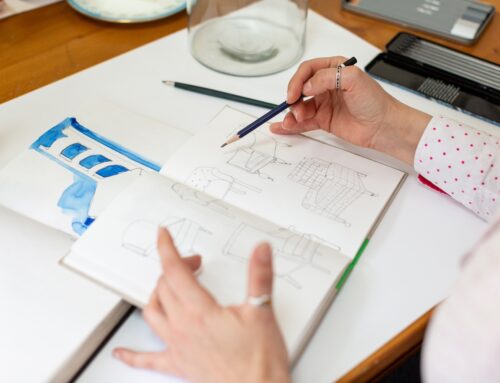The top 10 ways to improve your drawing!
(There are more. A lifetime of drawing more!)
In a recent questionnaire sent out to my community one of the most popular requests that came back to me was how do I improve my drawing? What do I need to do?
I thought I would quickly compile some of the tried and tested approaches that I know to work for my own practice. The top 10 ways to improve your drawing is partly lifted from my 30 Day Drawing Planner Guide which comes complete with 20 minute filmed lessons on how to embed the principles I speak of below. If this is something close to your heart I’d encourage you to check out this challenge starting in June and then uploaded as part of my Scratch to Sketch Hub!
Underpinning these top tips is the law of practice! I often think that the top tips in themselves are not the challenging aspect to building a drawing skill but rather how consistent, focused, inspired and tenacious we are in implementing them in our day to day.
Conscious awareness is also another. Have you ever drawn a picture you’re happy with and then tried the same approach again and struggled to get it right? Are you aware of the logical drawing process you need embed to get the same results time and time again? There is absolutely a science to the art of drawing! Once you work out the science you then discover how to use it to work on your own creative style.
Mistake making is also a fundamental part of the process – the sooner we come to realise that this aspect is equitable to learning at almost double speed we’d be filling more sketchbooks with our mistakes only to eventually come to realise that we have developed our own creative style with our realising we are doing so.
Table of Contents
The Top Ten Ways To Improve Your Drawing.
1. The Basic Principles!
Start with the basic principles. Mastering these basics of drawing is crucial! I preach this constantly in all my live sessions. Remember that we sometimes come into the drawing practice assuming we need to know automatically what to do. Drawing is a skill. Skills can be learned. Check out my blog post on the basic principles if you are not familiar with what these are. Embed these principles into your everyday drawing! If you’re interested in getting stuck into them further I expand on them in greater depth in the Scratch to Sketch Hub community.
2. Learn to LOOK!
“Learning to Draw is really a matter of learning to see – to see correctly – and that means a good deal more than merely looking with the eye. The sort of seeing I mean is an observation that utilises as many of the five senses as can reach through the eye at one time.”
Kimon Nicolaides. The Natural Way to Draw.
When you learn to draw you have to teach yourself how to truly see what is in front of you. Observe and analyse in a totally new way. Train yourself to observe the world around you more closely. Give time and thorough thought to how to study objects, people, and nature. It is this thoroughness of thought that paves the way for other massive changes in our emotional make up! We slow down to look at something in greater detail. We see beyond our own understanding of something. Draw what you see and not what you think you see! Isn’t it great to not have to rely on our own understanding of something in order to capture it on paper? Or using another analogy, imagine you are an alien that has landed on planet earth and have to draw everything you see to report back not knowing what it is? You can bet that the alien’s drawing might be more accurate than the ones we may draw. Pay attention to details, shapes, shadows, and textures and ask yourself constantly – I wonder how I would draw this on the paper? Breaking down what you see will help you better translate it onto paper.
3. Practice. Practice. And then practice some more….
The largest challenge to practicing is deciding when and how you are going to do so! You HAVE to dedicate regular time to drawing. Set aside specific periods each day or week to practice. My free Wednesday LIVE sessions online which you can book onto here are a regular drawing meeting. Consistency is key when it comes to improving any skill, including drawing. Practice, however, is easier said than done. Underpinning practice is the WILL to want to do it. And to have the will you need to have an idea of the vision or goal you want to achieve, even if as simple as learning to draw the basics. My vision was drawing anything anywhere using a proven formula! You can read more about my thoughts on practice here.
4. Try different subjects and styles.
I’m a great believer in varying the content of my sketchbooks continually. I love working on different subjects constantly. When you sign up to my Scratch to Sketchbook Community you are guaranteed a differently themed sketchbook every month!
Experiment with drawing various subjects, such as still life, landscapes, portraits, or animals. Did you know that I now have over 40+ event sessions for you to choose from my event vault within the Scratch to Sketch Hub? Additionally, explore different drawing styles, such as realistic, quick sketching, or simple mark making. This exploration will broaden your skills and help you discover your preferences.
Trying different things continually is a great way to keep you motivated when drawing – another essential element to always consider. Staying motivated is a core key principle of learning to draw. Continually sourcing and having ideas that enable you to keep practicing the basic principles is encapsulated in trying different subjects and styles.
5. Up for a Challenge?
Push yourself to engage with something external to your own efforts! Take drawing exercises and challenges. Engage in drawing exercises and challenges to push your boundaries. These could include drawing from imagination, drawing with limited time, or focusing on specific techniques like shading or cross-hatching. If you are new to drawing how about taking my 30 day challenge where you set aside 20 minutes to work through a set of drawing challenges with the outcome of embedding a more focused habit?
6. Learn from others!
Community! When I started Emily’s Notebook I loved how a community of like minded people got together and were connected by a creative passion. Accountability is such an important thing. Gentle accountability that is! As part of my membership there are opportunities for becoming accountable to support you maintain your drawing habit. Learning from others is the life blood of all I do too! I study the works of accomplished artists and seek inspiration from their styles and techniques. Book onto workshops, art classes, or join a community where you can learn from other artists and receive constructive feedback.
7. Use References.
References can be valuable tools for improving your drawing skills. Utilise photographs, objects, or even live models to study and replicate their forms, proportions, and details accurately. I draw for a minimum of 10 minutes a day from anything and everything during my day.
8. Simplify complex subjects
Drawing is simple. It is! Why? All you do when you draw is make a mark on a page. A line. A shape. A tone. Everything you draw can be broken down into simple stages. I teach the basic principles in a logical and sequential order. Forget the complexity of a subject! Break it down into simpler shapes and forms. Start with the contour. Work on the spaces and shapes that you see. This method will make complex subjects more manageable and less intimidating to draw.
9. Experiment with mediums:
One of my favourite things to do in my sketchbook is to simply work with a range of materials even though I have never been classically trained to do so! I think it’s important to explore various drawing mediums like pencils, coloured pencils, watercolours, ink, or pastels. (Don’t forget about the paper surface too!) Each medium has its unique characteristics, and experimenting with them will help you find the one that suits your style and preferences. A word of warning though. Don’t rush out and buy lots. Buy a little at a time. A favourite coloured pencil. A tube of bright paint. Always use what you have because it will inspire momentum rather than overwhelm. Having too much to choose from can lead to overwhelm quickly. (Plus you’ll find you won’t use as much as you thought you’d need!)
10. Seek constructive criticism
I love commenting on work that I receive from my community. In fact I believe that this is essential to support you sometimes see what you may not spot initially. Very often it links back to basic prinicples. Don’t be afraid to share your work with others and ask for feedback. Constructive criticism from fellow artists or community members can provide valuable insights and help you identify areas for improvement.
How many of these can you relate to?
Which ones do you implement regularly?
What do you think you need support to do?
Implementing these points in your drawing practice takes time, resilience and a profound curiosity, not only in the craft of drawing but also in yourself and how you seek to improve.
If you haven’t already I’d encourage you to consider the Scratch to Sketch Hub where all of these founding principles are woven into materials designed to make the journey of learning to draw a step by step process that you can follow. Drop me a line and tell me which of the above points you relate to!







